Integrated Accounting Project 2: Accounting Behavior and Control
VerifiedAdded on 2022/08/23
|13
|3275
|16
Project
AI Summary
This project analyzes the co-operative and mutual enterprise (CME) sector in Australia, utilizing the Australian CME Index (ACMEI) for longitudinal study. It explores research methodology, including deductive approaches and explanatory research designs. The project examines research opinions, philosophy (positivism, interpretivism, realism, and pragmatism), and justifies the selection of the chosen research approach. Data collection methods, including primary (quantitative) and secondary data, are discussed, along with sampling and ethical considerations. The project uses the deductive approach with quantitative data analysis to evaluate past trends and existing models. The data collection process involves surveys and secondary data from journals, articles, and websites. The project concludes with ethical considerations, limitations, and a summary of findings, providing a comprehensive overview of the CME sector and its financial aspects.
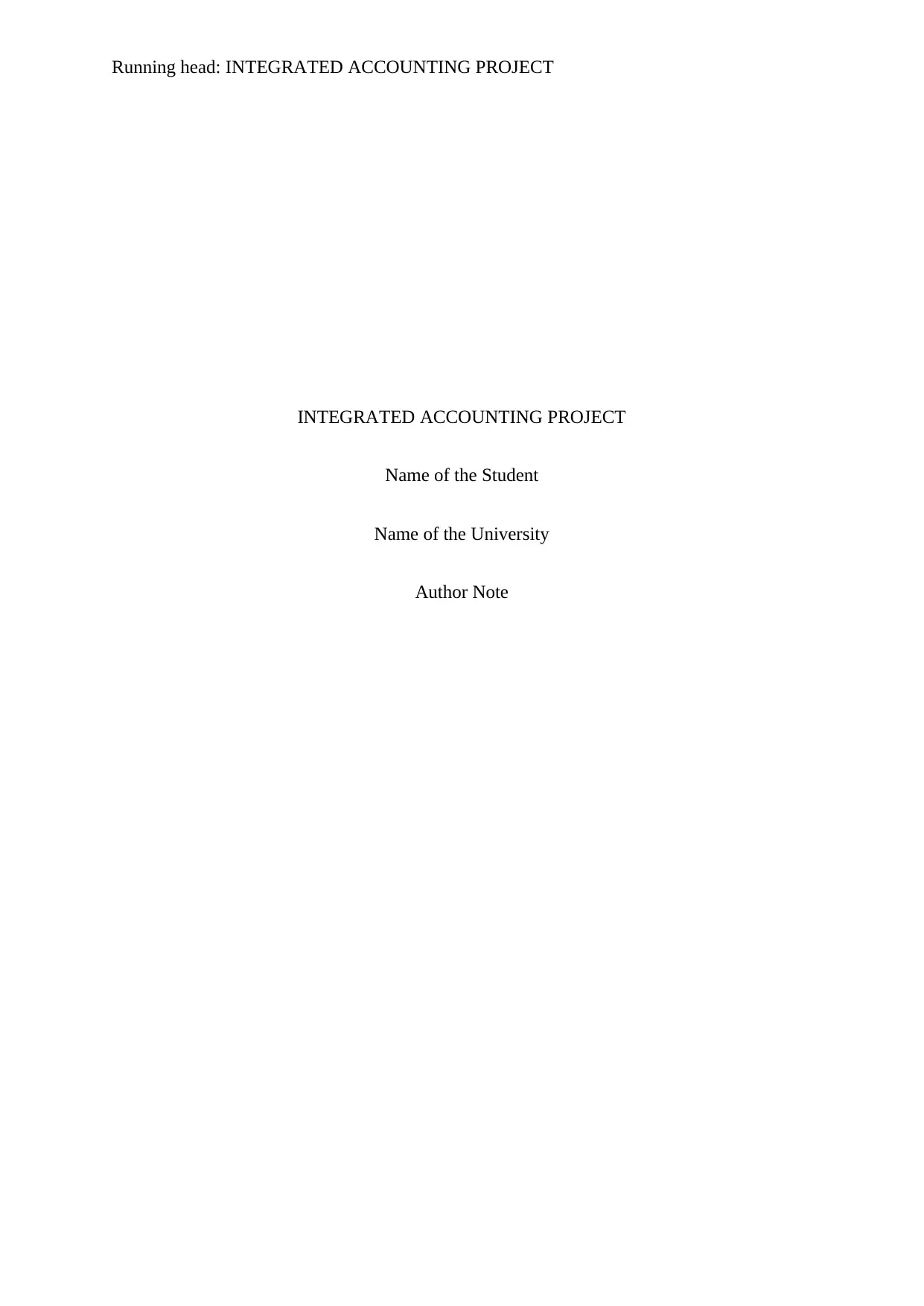
Running head: INTEGRATED ACCOUNTING PROJECT
INTEGRATED ACCOUNTING PROJECT
Name of the Student
Name of the University
Author Note
INTEGRATED ACCOUNTING PROJECT
Name of the Student
Name of the University
Author Note
Paraphrase This Document
Need a fresh take? Get an instant paraphrase of this document with our AI Paraphraser
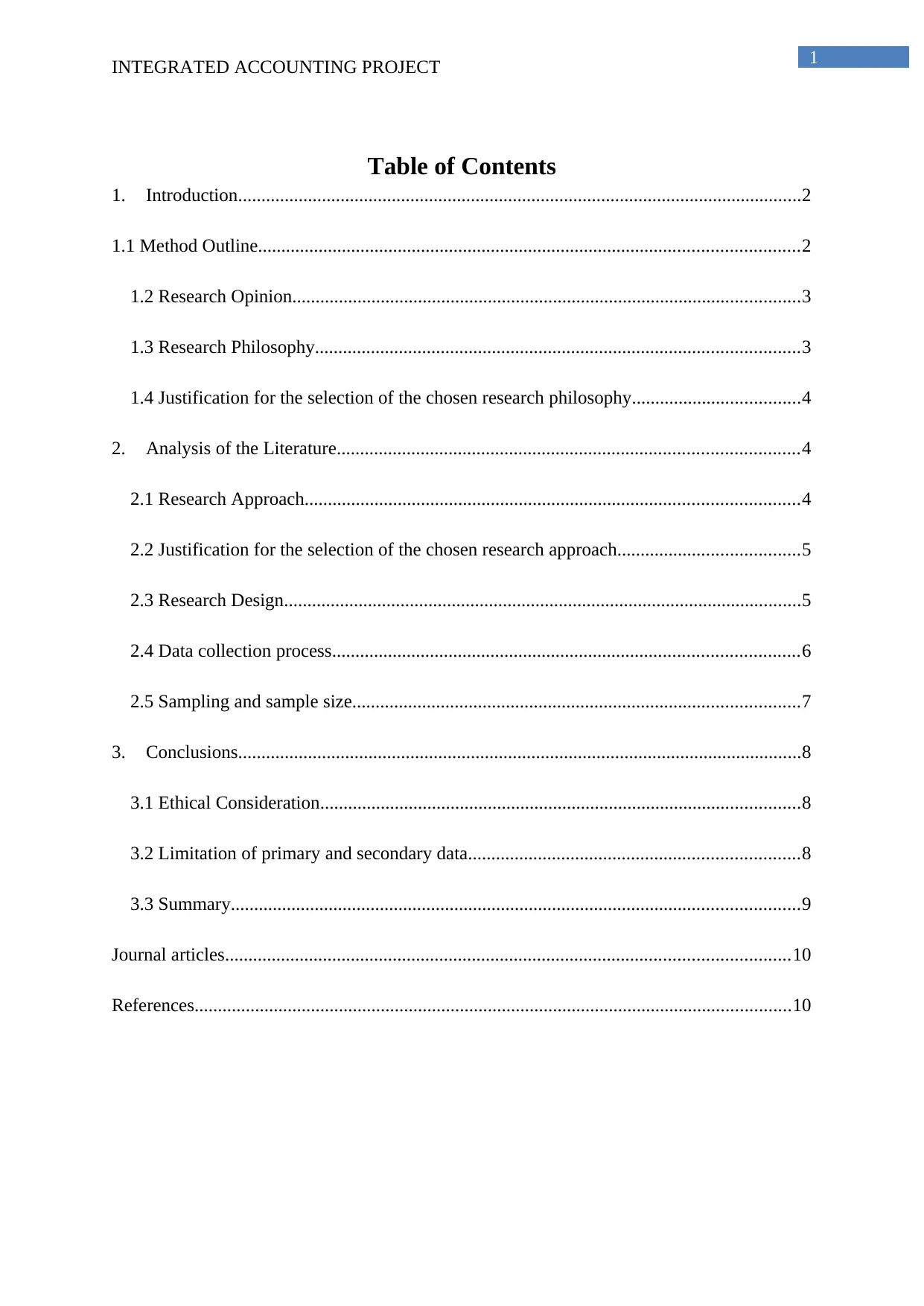
1
INTEGRATED ACCOUNTING PROJECT
Table of Contents
1. Introduction.........................................................................................................................2
1.1 Method Outline....................................................................................................................2
1.2 Research Opinion.............................................................................................................3
1.3 Research Philosophy........................................................................................................3
1.4 Justification for the selection of the chosen research philosophy....................................4
2. Analysis of the Literature...................................................................................................4
2.1 Research Approach..........................................................................................................4
2.2 Justification for the selection of the chosen research approach.......................................5
2.3 Research Design...............................................................................................................5
2.4 Data collection process....................................................................................................6
2.5 Sampling and sample size................................................................................................7
3. Conclusions.........................................................................................................................8
3.1 Ethical Consideration.......................................................................................................8
3.2 Limitation of primary and secondary data.......................................................................8
3.3 Summary..........................................................................................................................9
Journal articles.........................................................................................................................10
References................................................................................................................................10
INTEGRATED ACCOUNTING PROJECT
Table of Contents
1. Introduction.........................................................................................................................2
1.1 Method Outline....................................................................................................................2
1.2 Research Opinion.............................................................................................................3
1.3 Research Philosophy........................................................................................................3
1.4 Justification for the selection of the chosen research philosophy....................................4
2. Analysis of the Literature...................................................................................................4
2.1 Research Approach..........................................................................................................4
2.2 Justification for the selection of the chosen research approach.......................................5
2.3 Research Design...............................................................................................................5
2.4 Data collection process....................................................................................................6
2.5 Sampling and sample size................................................................................................7
3. Conclusions.........................................................................................................................8
3.1 Ethical Consideration.......................................................................................................8
3.2 Limitation of primary and secondary data.......................................................................8
3.3 Summary..........................................................................................................................9
Journal articles.........................................................................................................................10
References................................................................................................................................10

2
INTEGRATED ACCOUNTING PROJECT
1. Introduction
The research paper that has been taken for this assignment for mapping the size and
structure, which is, related to the Co-operative and Mutual enterprise (CME) sector in
Australia. With the longitudinal study which has been provided by the Australian CME Index
(ACMEI), does provides a better understanding of the forms that does operates in Australia,
also it provides a huge contribution related to the social and economic contribution to the
national economy. The report that has been taken is the fourth annual report of the Australian
Co-operative and Mutual Enterprise (CME) sector and it does have all the information related
to the previous studies, which also includes the comparison. The article that has been taken is
the long-term study of the Australian Co-operative and Mutual Enterprise Index (ACMEI),
which do have a goal in developing a comprehensive understanding, which does depending
upon the impact of the co-operative and mutual enterprise (CME) sector on the Australian
economy and society.
1.1 Method Outline
In this method outline, the researcher does have a clear aim upon the research
methodology. Several techniques have been implemented in the research so that it can
acquire some specific results. Several cooperatives exited in France in the middle ages and in
the Europe and United Kingdom, which is in the time of eighteenth century. In the foundation
of the Rochdale Society of Equitable Pioneers in the year 1844, in England, there were
several marks, which help in the creation of first modern co-operative. However, this legacy
of this society helped in pursuing both the economic and social goals that was within the
constitutional framework, which does have a set of guiding principles that enhances the well-
being of members. There has been deductive approach, which does help in the authentic
INTEGRATED ACCOUNTING PROJECT
1. Introduction
The research paper that has been taken for this assignment for mapping the size and
structure, which is, related to the Co-operative and Mutual enterprise (CME) sector in
Australia. With the longitudinal study which has been provided by the Australian CME Index
(ACMEI), does provides a better understanding of the forms that does operates in Australia,
also it provides a huge contribution related to the social and economic contribution to the
national economy. The report that has been taken is the fourth annual report of the Australian
Co-operative and Mutual Enterprise (CME) sector and it does have all the information related
to the previous studies, which also includes the comparison. The article that has been taken is
the long-term study of the Australian Co-operative and Mutual Enterprise Index (ACMEI),
which do have a goal in developing a comprehensive understanding, which does depending
upon the impact of the co-operative and mutual enterprise (CME) sector on the Australian
economy and society.
1.1 Method Outline
In this method outline, the researcher does have a clear aim upon the research
methodology. Several techniques have been implemented in the research so that it can
acquire some specific results. Several cooperatives exited in France in the middle ages and in
the Europe and United Kingdom, which is in the time of eighteenth century. In the foundation
of the Rochdale Society of Equitable Pioneers in the year 1844, in England, there were
several marks, which help in the creation of first modern co-operative. However, this legacy
of this society helped in pursuing both the economic and social goals that was within the
constitutional framework, which does have a set of guiding principles that enhances the well-
being of members. There has been deductive approach, which does help in the authentic
⊘ This is a preview!⊘
Do you want full access?
Subscribe today to unlock all pages.

Trusted by 1+ million students worldwide
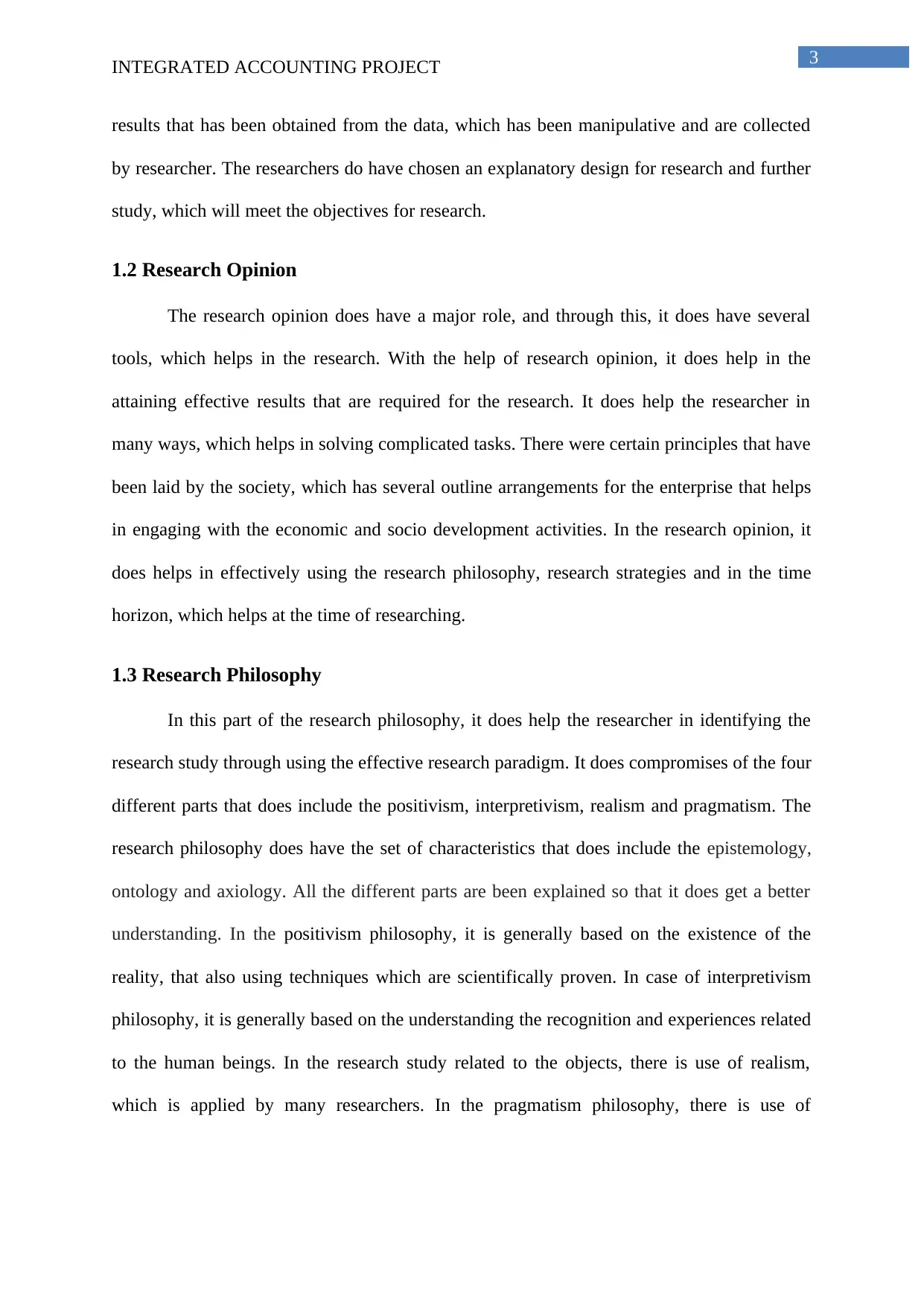
3
INTEGRATED ACCOUNTING PROJECT
results that has been obtained from the data, which has been manipulative and are collected
by researcher. The researchers do have chosen an explanatory design for research and further
study, which will meet the objectives for research.
1.2 Research Opinion
The research opinion does have a major role, and through this, it does have several
tools, which helps in the research. With the help of research opinion, it does help in the
attaining effective results that are required for the research. It does help the researcher in
many ways, which helps in solving complicated tasks. There were certain principles that have
been laid by the society, which has several outline arrangements for the enterprise that helps
in engaging with the economic and socio development activities. In the research opinion, it
does helps in effectively using the research philosophy, research strategies and in the time
horizon, which helps at the time of researching.
1.3 Research Philosophy
In this part of the research philosophy, it does help the researcher in identifying the
research study through using the effective research paradigm. It does compromises of the four
different parts that does include the positivism, interpretivism, realism and pragmatism. The
research philosophy does have the set of characteristics that does include the epistemology,
ontology and axiology. All the different parts are been explained so that it does get a better
understanding. In the positivism philosophy, it is generally based on the existence of the
reality, that also using techniques which are scientifically proven. In case of interpretivism
philosophy, it is generally based on the understanding the recognition and experiences related
to the human beings. In the research study related to the objects, there is use of realism,
which is applied by many researchers. In the pragmatism philosophy, there is use of
INTEGRATED ACCOUNTING PROJECT
results that has been obtained from the data, which has been manipulative and are collected
by researcher. The researchers do have chosen an explanatory design for research and further
study, which will meet the objectives for research.
1.2 Research Opinion
The research opinion does have a major role, and through this, it does have several
tools, which helps in the research. With the help of research opinion, it does help in the
attaining effective results that are required for the research. It does help the researcher in
many ways, which helps in solving complicated tasks. There were certain principles that have
been laid by the society, which has several outline arrangements for the enterprise that helps
in engaging with the economic and socio development activities. In the research opinion, it
does helps in effectively using the research philosophy, research strategies and in the time
horizon, which helps at the time of researching.
1.3 Research Philosophy
In this part of the research philosophy, it does help the researcher in identifying the
research study through using the effective research paradigm. It does compromises of the four
different parts that does include the positivism, interpretivism, realism and pragmatism. The
research philosophy does have the set of characteristics that does include the epistemology,
ontology and axiology. All the different parts are been explained so that it does get a better
understanding. In the positivism philosophy, it is generally based on the existence of the
reality, that also using techniques which are scientifically proven. In case of interpretivism
philosophy, it is generally based on the understanding the recognition and experiences related
to the human beings. In the research study related to the objects, there is use of realism,
which is applied by many researchers. In the pragmatism philosophy, there is use of
Paraphrase This Document
Need a fresh take? Get an instant paraphrase of this document with our AI Paraphraser
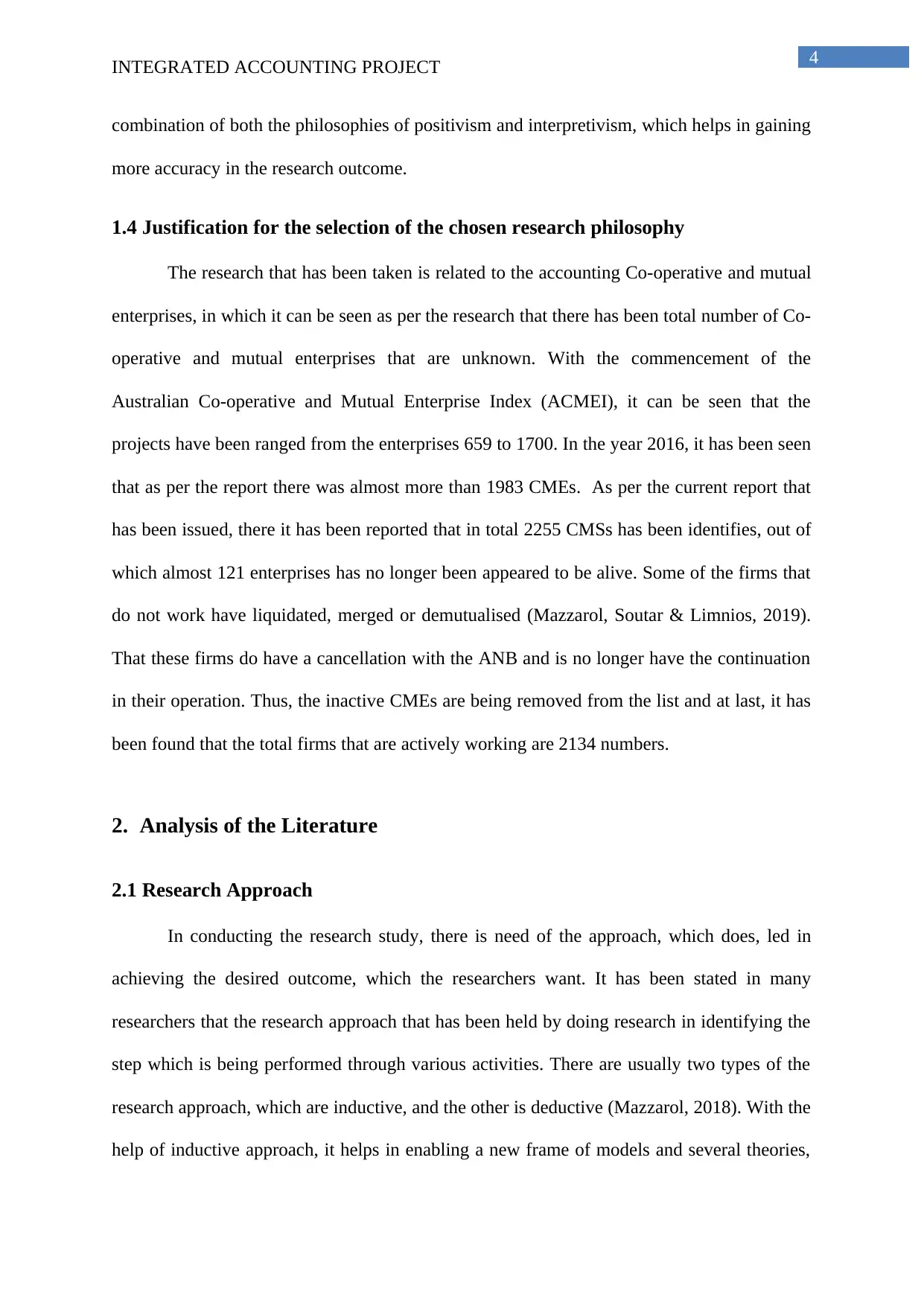
4
INTEGRATED ACCOUNTING PROJECT
combination of both the philosophies of positivism and interpretivism, which helps in gaining
more accuracy in the research outcome.
1.4 Justification for the selection of the chosen research philosophy
The research that has been taken is related to the accounting Co-operative and mutual
enterprises, in which it can be seen as per the research that there has been total number of Co-
operative and mutual enterprises that are unknown. With the commencement of the
Australian Co-operative and Mutual Enterprise Index (ACMEI), it can be seen that the
projects have been ranged from the enterprises 659 to 1700. In the year 2016, it has been seen
that as per the report there was almost more than 1983 CMEs. As per the current report that
has been issued, there it has been reported that in total 2255 CMSs has been identifies, out of
which almost 121 enterprises has no longer been appeared to be alive. Some of the firms that
do not work have liquidated, merged or demutualised (Mazzarol, Soutar & Limnios, 2019).
That these firms do have a cancellation with the ANB and is no longer have the continuation
in their operation. Thus, the inactive CMEs are being removed from the list and at last, it has
been found that the total firms that are actively working are 2134 numbers.
2. Analysis of the Literature
2.1 Research Approach
In conducting the research study, there is need of the approach, which does, led in
achieving the desired outcome, which the researchers want. It has been stated in many
researchers that the research approach that has been held by doing research in identifying the
step which is being performed through various activities. There are usually two types of the
research approach, which are inductive, and the other is deductive (Mazzarol, 2018). With the
help of inductive approach, it helps in enabling a new frame of models and several theories,
INTEGRATED ACCOUNTING PROJECT
combination of both the philosophies of positivism and interpretivism, which helps in gaining
more accuracy in the research outcome.
1.4 Justification for the selection of the chosen research philosophy
The research that has been taken is related to the accounting Co-operative and mutual
enterprises, in which it can be seen as per the research that there has been total number of Co-
operative and mutual enterprises that are unknown. With the commencement of the
Australian Co-operative and Mutual Enterprise Index (ACMEI), it can be seen that the
projects have been ranged from the enterprises 659 to 1700. In the year 2016, it has been seen
that as per the report there was almost more than 1983 CMEs. As per the current report that
has been issued, there it has been reported that in total 2255 CMSs has been identifies, out of
which almost 121 enterprises has no longer been appeared to be alive. Some of the firms that
do not work have liquidated, merged or demutualised (Mazzarol, Soutar & Limnios, 2019).
That these firms do have a cancellation with the ANB and is no longer have the continuation
in their operation. Thus, the inactive CMEs are being removed from the list and at last, it has
been found that the total firms that are actively working are 2134 numbers.
2. Analysis of the Literature
2.1 Research Approach
In conducting the research study, there is need of the approach, which does, led in
achieving the desired outcome, which the researchers want. It has been stated in many
researchers that the research approach that has been held by doing research in identifying the
step which is being performed through various activities. There are usually two types of the
research approach, which are inductive, and the other is deductive (Mazzarol, 2018). With the
help of inductive approach, it helps in enabling a new frame of models and several theories,
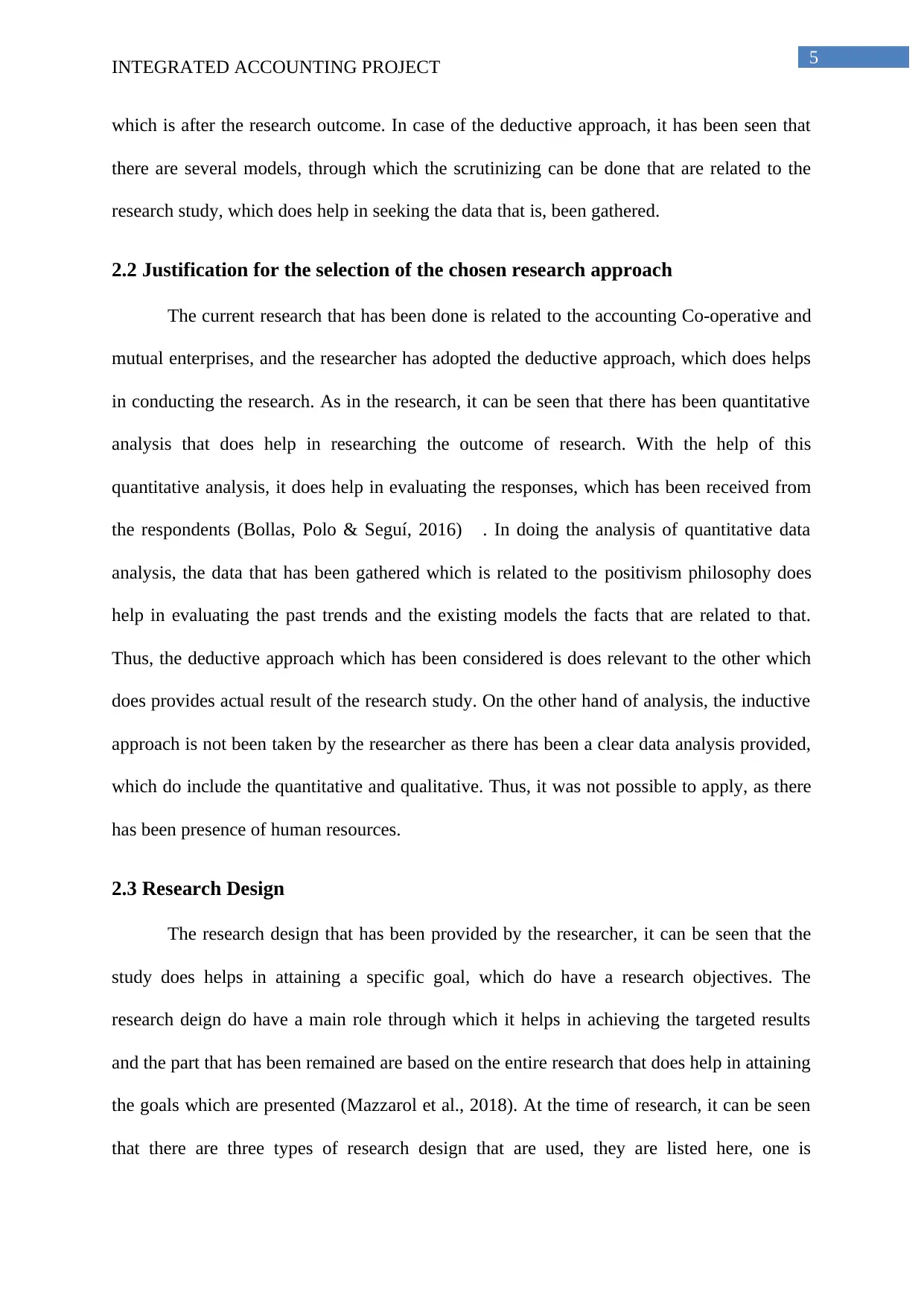
5
INTEGRATED ACCOUNTING PROJECT
which is after the research outcome. In case of the deductive approach, it has been seen that
there are several models, through which the scrutinizing can be done that are related to the
research study, which does help in seeking the data that is, been gathered.
2.2 Justification for the selection of the chosen research approach
The current research that has been done is related to the accounting Co-operative and
mutual enterprises, and the researcher has adopted the deductive approach, which does helps
in conducting the research. As in the research, it can be seen that there has been quantitative
analysis that does help in researching the outcome of research. With the help of this
quantitative analysis, it does help in evaluating the responses, which has been received from
the respondents (Bollas, Polo & Seguí, 2016) . In doing the analysis of quantitative data
analysis, the data that has been gathered which is related to the positivism philosophy does
help in evaluating the past trends and the existing models the facts that are related to that.
Thus, the deductive approach which has been considered is does relevant to the other which
does provides actual result of the research study. On the other hand of analysis, the inductive
approach is not been taken by the researcher as there has been a clear data analysis provided,
which do include the quantitative and qualitative. Thus, it was not possible to apply, as there
has been presence of human resources.
2.3 Research Design
The research design that has been provided by the researcher, it can be seen that the
study does helps in attaining a specific goal, which do have a research objectives. The
research deign do have a main role through which it helps in achieving the targeted results
and the part that has been remained are based on the entire research that does help in attaining
the goals which are presented (Mazzarol et al., 2018). At the time of research, it can be seen
that there are three types of research design that are used, they are listed here, one is
INTEGRATED ACCOUNTING PROJECT
which is after the research outcome. In case of the deductive approach, it has been seen that
there are several models, through which the scrutinizing can be done that are related to the
research study, which does help in seeking the data that is, been gathered.
2.2 Justification for the selection of the chosen research approach
The current research that has been done is related to the accounting Co-operative and
mutual enterprises, and the researcher has adopted the deductive approach, which does helps
in conducting the research. As in the research, it can be seen that there has been quantitative
analysis that does help in researching the outcome of research. With the help of this
quantitative analysis, it does help in evaluating the responses, which has been received from
the respondents (Bollas, Polo & Seguí, 2016) . In doing the analysis of quantitative data
analysis, the data that has been gathered which is related to the positivism philosophy does
help in evaluating the past trends and the existing models the facts that are related to that.
Thus, the deductive approach which has been considered is does relevant to the other which
does provides actual result of the research study. On the other hand of analysis, the inductive
approach is not been taken by the researcher as there has been a clear data analysis provided,
which do include the quantitative and qualitative. Thus, it was not possible to apply, as there
has been presence of human resources.
2.3 Research Design
The research design that has been provided by the researcher, it can be seen that the
study does helps in attaining a specific goal, which do have a research objectives. The
research deign do have a main role through which it helps in achieving the targeted results
and the part that has been remained are based on the entire research that does help in attaining
the goals which are presented (Mazzarol et al., 2018). At the time of research, it can be seen
that there are three types of research design that are used, they are listed here, one is
⊘ This is a preview!⊘
Do you want full access?
Subscribe today to unlock all pages.

Trusted by 1+ million students worldwide

6
INTEGRATED ACCOUNTING PROJECT
explanatory, second one is exploratory and the last one is descriptive. In this the explanatory
research design is being used as it does helps in explaining the forecasting the possible
outcomes that will be seen in the future and in the ongoing process.
2.4 Data collection process
Data is collected and jotted, as the initial need to guarantee the success of a research
study, in which the assemblage of necessary data is based on the nature of study and the
targeted outcomes to be reached. In this context, researchers concluded that data could be
segregated as primary and secondary data.
The secondary data is usually obtained from the secondary sources, which include
hard copies, journals, books and websites to understand the analytical conditions and
previous data presentation (Wallace, 2016). This process will help analyze the present trend
of the research issue that is verified. It is noted that secondary data has been elected more,
compared to primary data, as it is easily attainable from offline and online sources.
However, it is argued that since primary data is listed from the physical responses of
human beings by reaching out to them personally and getting to know the stories from people
personally, it is more genuine naturally as compared that of the secondary data.
Hence, relying on research analysis, the researcher requires both primary as well as
secondary data without focusing on just particular one. The primary data can also be
categorized into quantitative and qualitative data (Morrison & Mills, 2016). To carry out this
particular research, quantitative data is used. The qualitative data is not possible to collect due
to the lack of availability of time for obtaining the research study.
Quantitative Data:
Quantitative data are the steps of values that are expressed in numerical or numeric
variables for examples questions related to “how much” or “how often”. It implies the bit of
information that can be estimated to deduct the information in perspective of the research
INTEGRATED ACCOUNTING PROJECT
explanatory, second one is exploratory and the last one is descriptive. In this the explanatory
research design is being used as it does helps in explaining the forecasting the possible
outcomes that will be seen in the future and in the ongoing process.
2.4 Data collection process
Data is collected and jotted, as the initial need to guarantee the success of a research
study, in which the assemblage of necessary data is based on the nature of study and the
targeted outcomes to be reached. In this context, researchers concluded that data could be
segregated as primary and secondary data.
The secondary data is usually obtained from the secondary sources, which include
hard copies, journals, books and websites to understand the analytical conditions and
previous data presentation (Wallace, 2016). This process will help analyze the present trend
of the research issue that is verified. It is noted that secondary data has been elected more,
compared to primary data, as it is easily attainable from offline and online sources.
However, it is argued that since primary data is listed from the physical responses of
human beings by reaching out to them personally and getting to know the stories from people
personally, it is more genuine naturally as compared that of the secondary data.
Hence, relying on research analysis, the researcher requires both primary as well as
secondary data without focusing on just particular one. The primary data can also be
categorized into quantitative and qualitative data (Morrison & Mills, 2016). To carry out this
particular research, quantitative data is used. The qualitative data is not possible to collect due
to the lack of availability of time for obtaining the research study.
Quantitative Data:
Quantitative data are the steps of values that are expressed in numerical or numeric
variables for examples questions related to “how much” or “how often”. It implies the bit of
information that can be estimated to deduct the information in perspective of the research
Paraphrase This Document
Need a fresh take? Get an instant paraphrase of this document with our AI Paraphraser

7
INTEGRATED ACCOUNTING PROJECT
outcomes. Accordingly, this data provides the material on the subject of the predilection of
human perspective, which is of concerned of any particular study information. Therefore, it
needs comparatively bigger sample size for its interpretation (Webb, 2017). Particularly in
this research, the staff responsible for the industry of any particular location has been chosen
as the respondents to testify and understand the problems of the quality check department.
The candidate has collected both primary and secondary data from various sources. In
this regard, it is stated that the data has to be generated from genuine and authentic sources
for concluding in a valid and authorized way on the research analysis.
Primary data collection:
The candidate has listed the primary data collection by taking various surveys from
the IT professionals, those working with the quality check department of a particular location.
For conducting the study, he\she has arranged a preplanned questionnaire, which is the most
important content for a research and a necessity, and hence it includes both open-ended and
close-ended questions (Adams & Deakin, 2017). With regard to that, it is said that survey is
the best-known option to narrow down quantitative data, since it ensures gathering of
considerable data from a large sample. For a current study, the survey questionnaire is
developed to gather relevant information. Initially, the questionnaire is sent out to the
professionals of various sectors and after that, it was uploaded on social media. However, it is
also distributed through emails and various other communication ways to those who showed
interest. A period of 7 days is given to fill up the questionnaire and carry out the survey.
Secondary Data Collection:
The secondary data is also collected from various sources like previous research papers,
journals, articles, books and websites related to the industry’s of the particular location. In the
present research, the literature review chapter is built by collecting the secondary data to
relate the results of the study with the research aims and objectives.
INTEGRATED ACCOUNTING PROJECT
outcomes. Accordingly, this data provides the material on the subject of the predilection of
human perspective, which is of concerned of any particular study information. Therefore, it
needs comparatively bigger sample size for its interpretation (Webb, 2017). Particularly in
this research, the staff responsible for the industry of any particular location has been chosen
as the respondents to testify and understand the problems of the quality check department.
The candidate has collected both primary and secondary data from various sources. In
this regard, it is stated that the data has to be generated from genuine and authentic sources
for concluding in a valid and authorized way on the research analysis.
Primary data collection:
The candidate has listed the primary data collection by taking various surveys from
the IT professionals, those working with the quality check department of a particular location.
For conducting the study, he\she has arranged a preplanned questionnaire, which is the most
important content for a research and a necessity, and hence it includes both open-ended and
close-ended questions (Adams & Deakin, 2017). With regard to that, it is said that survey is
the best-known option to narrow down quantitative data, since it ensures gathering of
considerable data from a large sample. For a current study, the survey questionnaire is
developed to gather relevant information. Initially, the questionnaire is sent out to the
professionals of various sectors and after that, it was uploaded on social media. However, it is
also distributed through emails and various other communication ways to those who showed
interest. A period of 7 days is given to fill up the questionnaire and carry out the survey.
Secondary Data Collection:
The secondary data is also collected from various sources like previous research papers,
journals, articles, books and websites related to the industry’s of the particular location. In the
present research, the literature review chapter is built by collecting the secondary data to
relate the results of the study with the research aims and objectives.
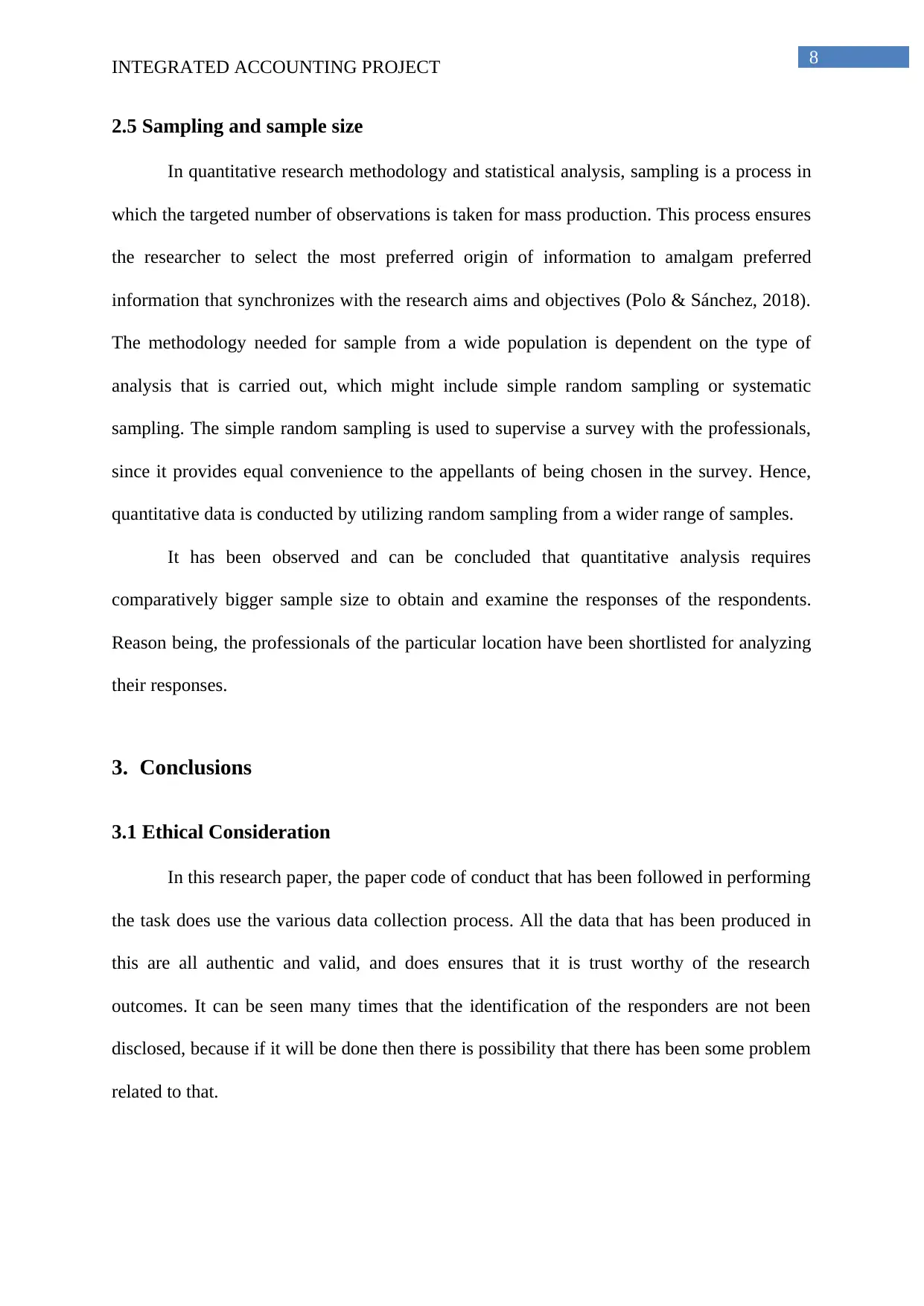
8
INTEGRATED ACCOUNTING PROJECT
2.5 Sampling and sample size
In quantitative research methodology and statistical analysis, sampling is a process in
which the targeted number of observations is taken for mass production. This process ensures
the researcher to select the most preferred origin of information to amalgam preferred
information that synchronizes with the research aims and objectives (Polo & Sánchez, 2018).
The methodology needed for sample from a wide population is dependent on the type of
analysis that is carried out, which might include simple random sampling or systematic
sampling. The simple random sampling is used to supervise a survey with the professionals,
since it provides equal convenience to the appellants of being chosen in the survey. Hence,
quantitative data is conducted by utilizing random sampling from a wider range of samples.
It has been observed and can be concluded that quantitative analysis requires
comparatively bigger sample size to obtain and examine the responses of the respondents.
Reason being, the professionals of the particular location have been shortlisted for analyzing
their responses.
3. Conclusions
3.1 Ethical Consideration
In this research paper, the paper code of conduct that has been followed in performing
the task does use the various data collection process. All the data that has been produced in
this are all authentic and valid, and does ensures that it is trust worthy of the research
outcomes. It can be seen many times that the identification of the responders are not been
disclosed, because if it will be done then there is possibility that there has been some problem
related to that.
INTEGRATED ACCOUNTING PROJECT
2.5 Sampling and sample size
In quantitative research methodology and statistical analysis, sampling is a process in
which the targeted number of observations is taken for mass production. This process ensures
the researcher to select the most preferred origin of information to amalgam preferred
information that synchronizes with the research aims and objectives (Polo & Sánchez, 2018).
The methodology needed for sample from a wide population is dependent on the type of
analysis that is carried out, which might include simple random sampling or systematic
sampling. The simple random sampling is used to supervise a survey with the professionals,
since it provides equal convenience to the appellants of being chosen in the survey. Hence,
quantitative data is conducted by utilizing random sampling from a wider range of samples.
It has been observed and can be concluded that quantitative analysis requires
comparatively bigger sample size to obtain and examine the responses of the respondents.
Reason being, the professionals of the particular location have been shortlisted for analyzing
their responses.
3. Conclusions
3.1 Ethical Consideration
In this research paper, the paper code of conduct that has been followed in performing
the task does use the various data collection process. All the data that has been produced in
this are all authentic and valid, and does ensures that it is trust worthy of the research
outcomes. It can be seen many times that the identification of the responders are not been
disclosed, because if it will be done then there is possibility that there has been some problem
related to that.
⊘ This is a preview!⊘
Do you want full access?
Subscribe today to unlock all pages.

Trusted by 1+ million students worldwide
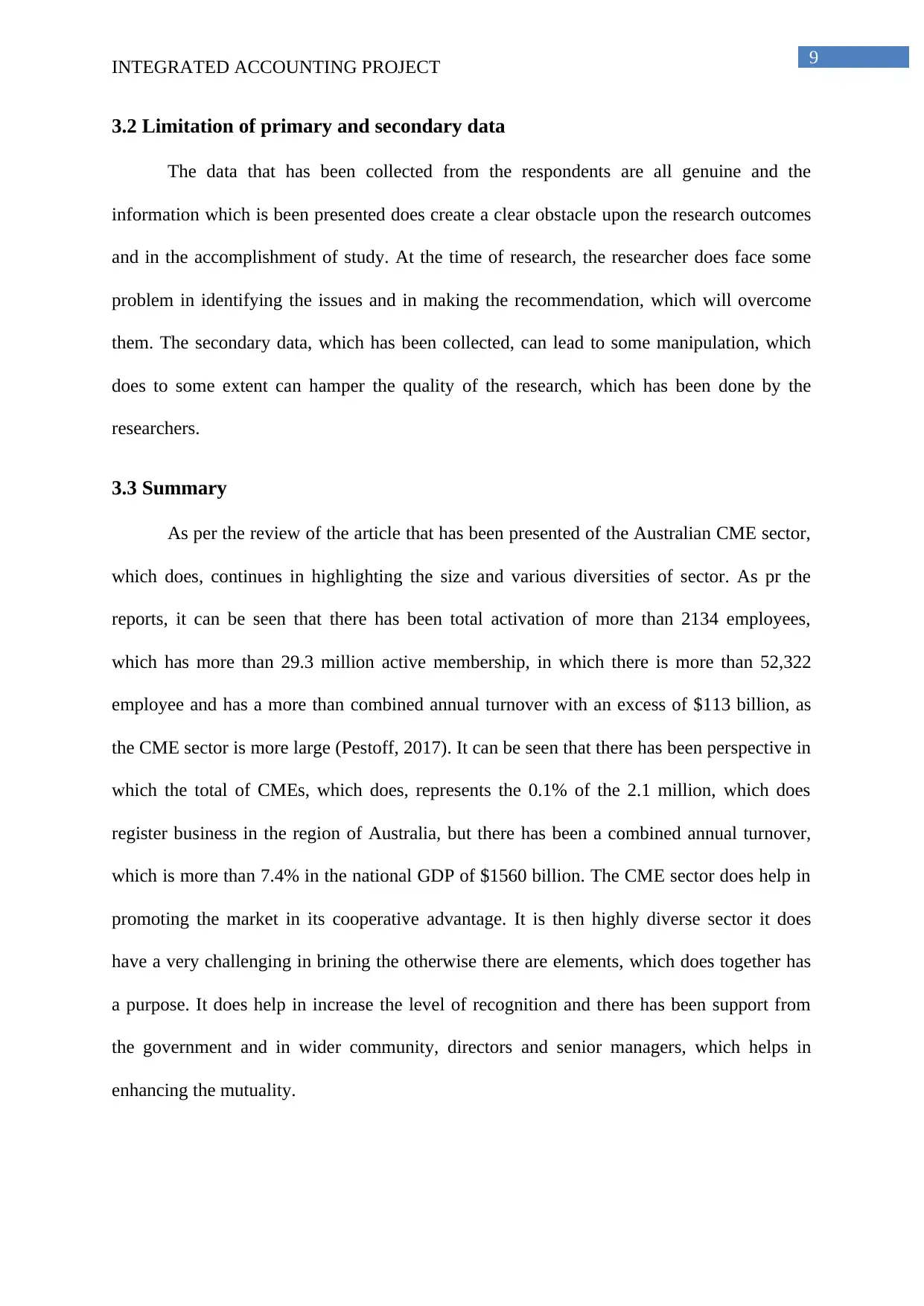
9
INTEGRATED ACCOUNTING PROJECT
3.2 Limitation of primary and secondary data
The data that has been collected from the respondents are all genuine and the
information which is been presented does create a clear obstacle upon the research outcomes
and in the accomplishment of study. At the time of research, the researcher does face some
problem in identifying the issues and in making the recommendation, which will overcome
them. The secondary data, which has been collected, can lead to some manipulation, which
does to some extent can hamper the quality of the research, which has been done by the
researchers.
3.3 Summary
As per the review of the article that has been presented of the Australian CME sector,
which does, continues in highlighting the size and various diversities of sector. As pr the
reports, it can be seen that there has been total activation of more than 2134 employees,
which has more than 29.3 million active membership, in which there is more than 52,322
employee and has a more than combined annual turnover with an excess of $113 billion, as
the CME sector is more large (Pestoff, 2017). It can be seen that there has been perspective in
which the total of CMEs, which does, represents the 0.1% of the 2.1 million, which does
register business in the region of Australia, but there has been a combined annual turnover,
which is more than 7.4% in the national GDP of $1560 billion. The CME sector does help in
promoting the market in its cooperative advantage. It is then highly diverse sector it does
have a very challenging in brining the otherwise there are elements, which does together has
a purpose. It does help in increase the level of recognition and there has been support from
the government and in wider community, directors and senior managers, which helps in
enhancing the mutuality.
INTEGRATED ACCOUNTING PROJECT
3.2 Limitation of primary and secondary data
The data that has been collected from the respondents are all genuine and the
information which is been presented does create a clear obstacle upon the research outcomes
and in the accomplishment of study. At the time of research, the researcher does face some
problem in identifying the issues and in making the recommendation, which will overcome
them. The secondary data, which has been collected, can lead to some manipulation, which
does to some extent can hamper the quality of the research, which has been done by the
researchers.
3.3 Summary
As per the review of the article that has been presented of the Australian CME sector,
which does, continues in highlighting the size and various diversities of sector. As pr the
reports, it can be seen that there has been total activation of more than 2134 employees,
which has more than 29.3 million active membership, in which there is more than 52,322
employee and has a more than combined annual turnover with an excess of $113 billion, as
the CME sector is more large (Pestoff, 2017). It can be seen that there has been perspective in
which the total of CMEs, which does, represents the 0.1% of the 2.1 million, which does
register business in the region of Australia, but there has been a combined annual turnover,
which is more than 7.4% in the national GDP of $1560 billion. The CME sector does help in
promoting the market in its cooperative advantage. It is then highly diverse sector it does
have a very challenging in brining the otherwise there are elements, which does together has
a purpose. It does help in increase the level of recognition and there has been support from
the government and in wider community, directors and senior managers, which helps in
enhancing the mutuality.
Paraphrase This Document
Need a fresh take? Get an instant paraphrase of this document with our AI Paraphraser

10
INTEGRATED ACCOUNTING PROJECT
INTEGRATED ACCOUNTING PROJECT

11
INTEGRATED ACCOUNTING PROJECT
Journal articles
(2020). Press-files.anu.edu.au. Retrieved 29 March 2020, from
http://press-files.anu.edu.au/downloads/press/n1949/pdf/ch14.pdf
(2020). Cemi.com.au. Retrieved 29 March 2020, from
https://cemi.com.au/sites/all/publications/CEMI-DP1701-Mazzarol-Kresling-2017.pdf
(2020). Bccm.coop. Retrieved 29 March 2020, from
https://bccm.coop/wp/wp-content/uploads/2018/09/5170-
GOV_Support_Doc_HR_FA.pdf
References
Adams, Z., & Deakin, S. (2017). Enterprise Form, Participation, and Performance in Mutuals
and Co-operatives. In The Oxford Handbook of Mutual, Co-Operative, and Co-
Owned Business.
Bollas-Araya, H. M., Polo-Garrido, F., & Seguí-Mas, E. (2016). Adoption of sustainability
reporting and assurance: a study among the top 300 cooperative and mutual
organizations. Journal of Co-operative Accounting and Reporting, 4(1), 59-78.
Mazzarol, T. (2018). Australia's Leading Co-operative and Mutual Enterprises in 2018:
CEMI Discussion Paper 1801. Available at SSRN 3307661.
Mazzarol, T., Clark, D., Reboud, S., & Limnios, E. M. (2018). Developing a conceptual
framework for the co-operative and mutual enterprise business model. Journal of
Management & Organization, 24(4), 551-581.
INTEGRATED ACCOUNTING PROJECT
Journal articles
(2020). Press-files.anu.edu.au. Retrieved 29 March 2020, from
http://press-files.anu.edu.au/downloads/press/n1949/pdf/ch14.pdf
(2020). Cemi.com.au. Retrieved 29 March 2020, from
https://cemi.com.au/sites/all/publications/CEMI-DP1701-Mazzarol-Kresling-2017.pdf
(2020). Bccm.coop. Retrieved 29 March 2020, from
https://bccm.coop/wp/wp-content/uploads/2018/09/5170-
GOV_Support_Doc_HR_FA.pdf
References
Adams, Z., & Deakin, S. (2017). Enterprise Form, Participation, and Performance in Mutuals
and Co-operatives. In The Oxford Handbook of Mutual, Co-Operative, and Co-
Owned Business.
Bollas-Araya, H. M., Polo-Garrido, F., & Seguí-Mas, E. (2016). Adoption of sustainability
reporting and assurance: a study among the top 300 cooperative and mutual
organizations. Journal of Co-operative Accounting and Reporting, 4(1), 59-78.
Mazzarol, T. (2018). Australia's Leading Co-operative and Mutual Enterprises in 2018:
CEMI Discussion Paper 1801. Available at SSRN 3307661.
Mazzarol, T., Clark, D., Reboud, S., & Limnios, E. M. (2018). Developing a conceptual
framework for the co-operative and mutual enterprise business model. Journal of
Management & Organization, 24(4), 551-581.
⊘ This is a preview!⊘
Do you want full access?
Subscribe today to unlock all pages.

Trusted by 1+ million students worldwide
1 out of 13
Related Documents
Your All-in-One AI-Powered Toolkit for Academic Success.
+13062052269
info@desklib.com
Available 24*7 on WhatsApp / Email
![[object Object]](/_next/static/media/star-bottom.7253800d.svg)
Unlock your academic potential
Copyright © 2020–2025 A2Z Services. All Rights Reserved. Developed and managed by ZUCOL.




